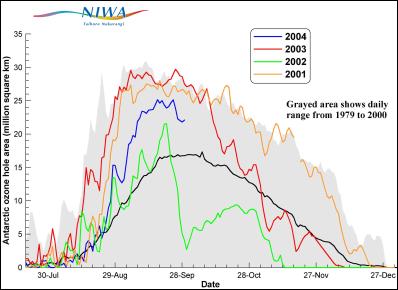Antarctic ozone hole – smaller this year
Antarctic ozone hole – smaller this year
The ozone hole over Antarctica appears to be about 20% smaller than last year's record-breaking ozone hole.
Measurements by the National Institute of Water & Atmospheric Research (NIWA), supported by Antarctica New Zealand, at Scott Base, Antarctica, are consistent with NASA satellite data showing the area of the hole peaked at about 24 million square kilometres, compared to 29 million square kilometres in 2003.

Graph showing the area of the ozone holes for the last four years. The hole this year (blue) is smaller than the very large ozone holes in 2003 (red) and 2001 (yellow), but larger than in 2002 (green). The average for the 22 years of measurement before that is shown in black.
“Measurements from the ground at Scott Base suggest that there is slightly more ozone this year than the average for recent years,” says NIWA atmospheric scientist Dr Stephen Wood. “But ozone levels are still lower than before the ozone hole started forming in the early 1980s.”
“The first spring measurements of ozone from Scott Base this year showed levels at around 200 Dobson Units (DU) but have been as low as 165 DU in the past week. Satellite measurements are reporting values as low as 110 DU in some parts of the hole. Before the early 1980s, ozone levels in Antarctica never went below 220 DU.”
The ozone hole is the result of a combination of factors: man-made chemicals containing chlorine and bromine; the isolation and cold of the Antarctic atmosphere during the polar winter; the formation of polar stratospheric clouds; the chemical reactions that occur on the surfaces of those clouds; and the return of sunlight in spring.
Although the man-made chemicals that contribute to ozone depletion are already starting to decline in the atmosphere (thanks to controls on their use under the Montreal Protocol), some of the other factors vary from year to year. Because of this natural variation, Dr Wood cautions against reading too much into the smaller size of the hole this year. “We need to see smaller or less severe ozone holes over a number of years before we can say for certain that ozone is recovering,” he says.
At present, the ozone-depleted air is well contained over Antarctica. The only inhabited area it could affect at the moment is the extreme tip of South America.
But Dr Wood says the hole will indirectly affect New Zealand later in the year. “When the ozone hole breaks up in November or early December, ozone-depleted air moves into surrounding areas in the southern hemisphere, including New Zealand. The later the ozone hole breaks up, the higher the sun is in the sky over New Zealand and the larger the effect on UV levels. If New Zealand experiences a combination of lower ozone with high sun and few clouds, then skin-damaging UV levels can be extreme.”
Research conducted at NIWA’s atmospheric research facility at Lauder, Central Otago, shows that approximately half the long-term ozone decline at mid-latitudes in the southern hemisphere (including New Zealand) has been caused by the export of ozone-depleted air from Antarctica. In recent years, there has been about ten percent less ozone over New Zealand in the summer than 30 years ago.
NIWA’s measurements of ozone near Scott Base are part of research funded by the Foundation for Research Science and Technology to understand what drives global change in the atmosphere. The ground-based measurements are also important for validating measurements taken from satellites.


 Ferry Holdings Limited: Decommissioning Of The Aratere Ferry
Ferry Holdings Limited: Decommissioning Of The Aratere Ferry Broadcasting Standards Authority: Inaccurate 1News Reporting On Football Violence Breached Broadcasting Standards
Broadcasting Standards Authority: Inaccurate 1News Reporting On Football Violence Breached Broadcasting Standards Better Taxes for a Better Future: $1b Cut In Budget Operating Allowance ‘Unnecessary And Damaging’
Better Taxes for a Better Future: $1b Cut In Budget Operating Allowance ‘Unnecessary And Damaging’ Transport Well NZ: Transport Well New Zealand Charitable Trust - A Vision For The Entire Sector
Transport Well NZ: Transport Well New Zealand Charitable Trust - A Vision For The Entire Sector KiwiRail: Auckland Rail Network Reopens After Successful Upgrades
KiwiRail: Auckland Rail Network Reopens After Successful Upgrades ChargeNet: EV infrastructure co-funding model welcomed
ChargeNet: EV infrastructure co-funding model welcomed